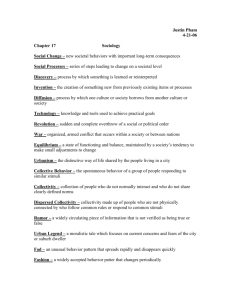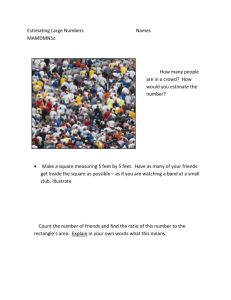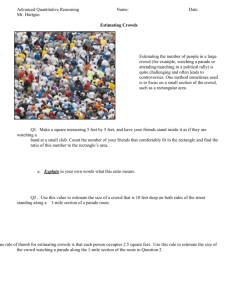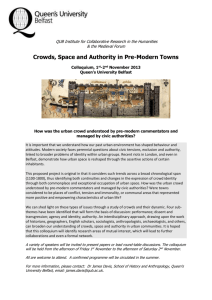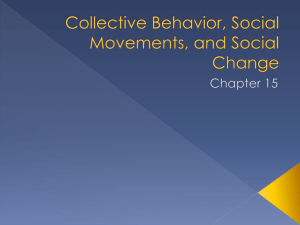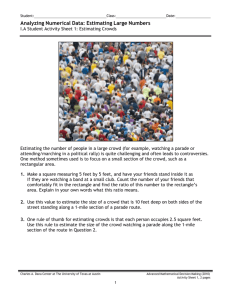the original article here.
advertisement
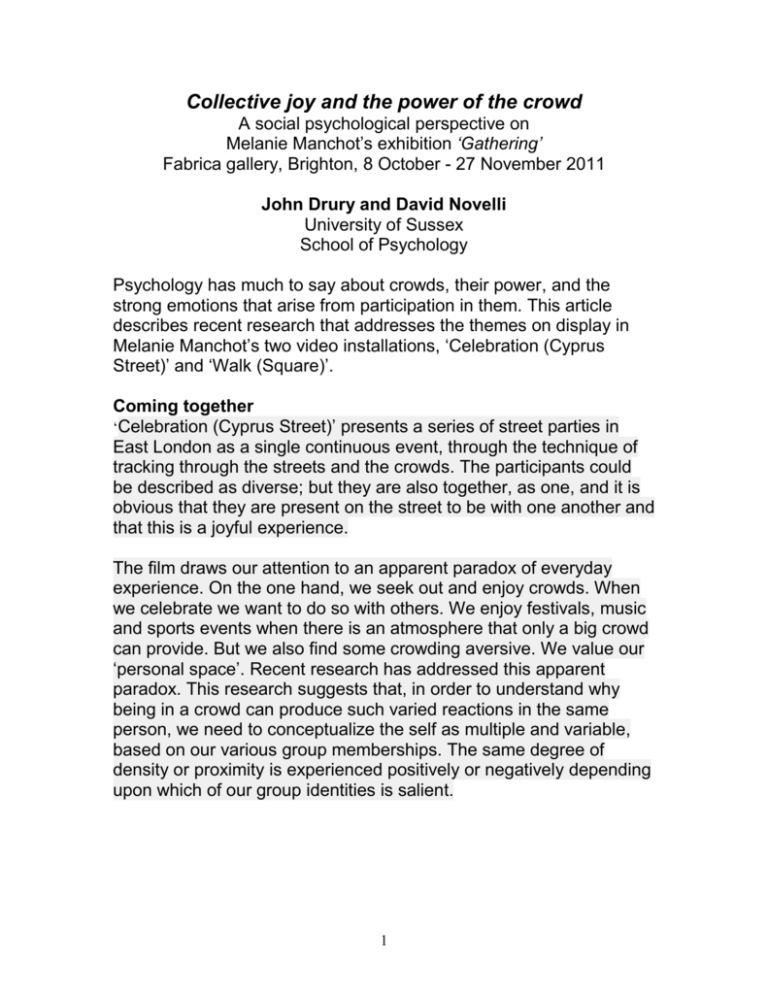
Collective joy and the power of the crowd A social psychological perspective on Melanie Manchot’s exhibition ‘Gathering’ Fabrica gallery, Brighton, 8 October - 27 November 2011 John Drury and David Novelli University of Sussex School of Psychology Psychology has much to say about crowds, their power, and the strong emotions that arise from participation in them. This article describes recent research that addresses the themes on display in Melanie Manchot’s two video installations, ‘Celebration (Cyprus Street)’ and ‘Walk (Square)’. Coming together ‘Celebration (Cyprus Street)’ presents a series of street parties in East London as a single continuous event, through the technique of tracking through the streets and the crowds. The participants could be described as diverse; but they are also together, as one, and it is obvious that they are present on the street to be with one another and that this is a joyful experience. The film draws our attention to an apparent paradox of everyday experience. On the one hand, we seek out and enjoy crowds. When we celebrate we want to do so with others. We enjoy festivals, music and sports events when there is an atmosphere that only a big crowd can provide. But we also find some crowding aversive. We value our ‘personal space’. Recent research has addressed this apparent paradox. This research suggests that, in order to understand why being in a crowd can produce such varied reactions in the same person, we need to conceptualize the self as multiple and variable, based on our various group memberships. The same degree of density or proximity is experienced positively or negatively depending upon which of our group identities is salient. 1 This argument can illustrated be with a recent experimental study.1 Participants were each invited to pull up a chair to wherever they felt most comfortable, in anticipation of discussion with a stranger. Prior to this, they had been given a bogus ‘test’ of their ‘communication styles’. They were told either that the stranger was of the same ‘communication style’ as them or a different style. In fact the test and hence the two ‘groups’ were meaningless. But the participants didn’t know this, and reliably positioned the chair closer to the expected ‘ingroup’ member than the ‘out-group’ member. This result suggests that our enjoyment (or dislike) of closeness with others, whether interpersonally or in a crowd, is shaped by whichever of our various identities is salient, rather than by a fixed ‘personal space’ boundary. The effect shown in this experiment has been replicated with a range of other measures,2 including self-reported preferences, negative and positive emotions, and even expressions of disgust: people report less disgust for exactly the same body odour when it is categorized as ‘us’ than when it is ‘them’! Studies of actual crowds provide some real-world validitation for this analysis. In November 2007, a march and rally was organized by UNISON, the public sector workers’ union, to protest against the then government’s attempts to privatize the NHS. We surveyed over 100 demonstrators, and found that those who identified most with the crowd sought a more central (i.e., more crowded) physical location, and hence closer proximity, to their fellow crowd members. In addition, immersion in the crowd was associated with collective joy. Specifically, those who identified most with the crowd reported a more positive experience, in part due to being in close physical proximity to their fellow crowd members.3 Recent research therefore says something about why we gather together with others (because they identify in the same way that we 1 Novelli, D., Drury, J., & Reicher, S. (2010). Come together: Two studies concerning the impact of group relations on ‘personal space’. British Journal of Social Psychology, 49, 223–236. 2 Novelli, D. (2010). The social psychology of spatiality and crowding. Unpublished DPhil thesis. University of Sussex. Available online at http://sro.sussex.ac.uk/6275/1/Novelli,_David_Lee.pdf 3 Novelli, D., Drury, J., & Reicher, S. (2011). The relationship between psychological and physical group processes and their impact on the experience of crowding: Evidence from a field study. Unpublished manuscript. University of Sussex. 2 do), and why it feels good when we are in a crowd with these others. But when we come together as a crowd we often move and act together. What are the psychological effects of such collective coordination? Acting together In Melanie Manchot’s video installation ‘Walk (Square)’, hundreds of school children are shown moving in lines toward a city square, where they merge to become part of a huge choreographed crowd. They then move together, synchronizing their walking to form patterns that change, dissolve and re-form. If the striking choreography leads the viewer to see the performers as a single entity, it is possible that the performers themselves may do the same, for this is what recent research in social psychology has found. In the NHS demonstration study described above, we found that participants’ sense of being part of the crowd – their social identity - increased through participation in the event. Collective joy also increased over the course of the event, and was partly due to this shared social identity. Our explanation for these results was that physical co-action in a group or crowd can dissolve the psychological boundary between individual and collective, while intensifying our positive emotional responses. But a field study like this cannot rule out the possibility that some other factor was responsible (such as passing of time, or communication, or changing relations with outside groups). A follow-up study was carried out in the psychology laboratory, which enabled us to control all the conditions and so identify any causal relations, rather than simply infer them as in the demonstration study.4 Participants arranged at close physical proximity in small groups were asked to learn clapping patterns of the type heard in football crowds. They performed the patterns in the group, either in synchrony or individually. As predicted, only participants who synchronized their movement came to see themselves as part of their group and experienced increased positive emotion. 4 Novelli, D., Drury, J., & Reicher, S. (2011). Synchronized movement as a cause of social identity and positive emotion. Unpublished manuscript. University of Sussex. 3 These studies therefore show that moving together as one in time can serve to construct a collective identity. This is why rallies and marches are important in building social movements. It is no coincidence that Melanie Manchot’s two works are inspired not only by mass pilgrimages, processions, and parades, but also by recent mass demonstrations across both the Arab world and the UK. A marching crowd is not only expressive, and therefore rich in meanings and symbols, but is also purposive. That purpose may be social change. Of course, that most crowds do not aim to bring about social change. Many crowds in fact only exist to reproduce or validate the status quo – for example through religious ritual or national ceremony. But social change very often involves crowds.5 Even crowd events that are supposed to have a cathartic function may also include a rebellious undertone, threatening to the status quo. Early carnivals had this dual quality;6 and riots are often described as having a ‘carnival atmosphere’, by both participants and those who observe them.7 Crowds and power therefore have a long association. Recent research has examined the psychology of power-change – empowerment – in people’s experience of crowd events. Studies of riots, anti-capitalist demonstrations, anti-roads direct actions, Reclaim the Streets parties, anti-war marches, and numerous experimental simulations have each shown the same pattern. We feel more able to take collective actions that we define as legitimate, yet which may not be permitted by others outside the crowd (such as the authorities and police), when we perceive that others in the crowd support us in our aims and action.8 Comparative studies of protest movements add that a sense of collective agency can be both cause and consequence of such 5 Ackerman, P., & Kruegler, C. (1994). Strategic nonviolent conflict: The dynamics of people power in the twentieth century. Westport, CT: Praeger. 6 Davis, N. Z. (1971). The reasons of misrule: Youth groups and charivaris in sixteenth-century France. Past and Present, 50, 41-75. 7 Reicher, S. & Potter, J. (1985). Psychological theory as intergroup perspective: A comparative analysis of ‘scientific’ and ‘lay’ accounts of crowd events. Human Relations, 38, 167-189. 8 Drury, J., & Reicher, S. (2009). Collective psychological empowerment as a model of social change: Researching crowds and power. Journal of Social Issues, 65, 707-725. 4 collective action.9 In order to act, we need to believe we are capable of action. But, through our action and its impact on the world, we authenticate and confirm such collective agency; the material results of our collective actions stand as evidence of the power of our collective identities. Finally, research on activists’ experiences shows that collective actions that shift or challenge existing power relations feel joyful, exhilarating and even euphoric.10 They feel good, and they may even be good for us, since the sense of agency and social support associated with collective action are established predictors of wellbeing.11 Melanie Manchot’s two works ‘Celebration (Cyprus Street)’ and ‘Walk (Square)’ are about the relationship between individual and crowd, about our collective identities, and about how we behave in public space. A central message is that, through its action, the crowd can both express and construct our sense of self. Recent research in social psychology suggests that the power of the crowd – the collective support, collective agency and collective joy it affords – comes not from a loss of self, but from the augmentation of the self. To paraphrase John Turner, a founder of the social identity approach in group psychology, the psychological crowd ‘is precisely the adaptive mechanism that frees human beings from the restrictions of, and allows them to be more than just, individual persons’ (Turner, 1987, p. 67).12 Dr John Drury is senior lecturer in social psychology at the University of Sussex. His research interests include crowd empowerment, solidarity in mass emergencies, and positive experiences of ‘crowding’. His research includes studies of anti-poll 9 Drury, J., & Reicher, S. (2005). Explaining enduring empowerment: A comparative study of collective action and psychological outcomes. European Journal of Social Psychology, 35, 35-58 10 Drury, J., Cocking, C., Beale, J., Hanson, C., & Rapley, F. (2005). The phenomenology of empowerment in collective action. British Journal of Social Psychology, 44, 309-328 11 Haslam, S. A., & Reicher, S. D. (2006). Stressing the group: Social identity and the unfolding dynamics of responses to stress. Journal of Applied Psychology, 91, 1037-1052. 12 Turner, J. (1987). A self-categorisation theory. In Turner, J. C., Hogg, M. A., Oakes, P. J., Reicher, S. D. & Wetherell, M. S., Rediscovering the social group: A self-categorization theory (pp. 42-67). Oxford: Blackwell. 5 tax riots and anti-roads direct action and survivor responses to the London bombings. He has just edited, with Dr Clifford Stott, a special issue of the journal Contemporary Social Science on the topic of crowds. He is currently supervising research projects on the Hajj to Mecca, collective action and wellbeing, and crowd communication by the emergency services. Dr David Novelli is a social psychologist at the University of Sussex, specialising in crowds. His research focuses on how social identities and group memberships influence the ways in which we experience being in crowds, and how acting together in crowds can affect positive emotions and feelings of solidarity. This year David was awarded the annual prize for the country’s most outstanding doctoral thesis by the British Psychological Society. He is currently looking at how our (positive and negative) experiences at large-scale music events can be shaped by assumptions about crowds held by those who organize and manage such events. 6
